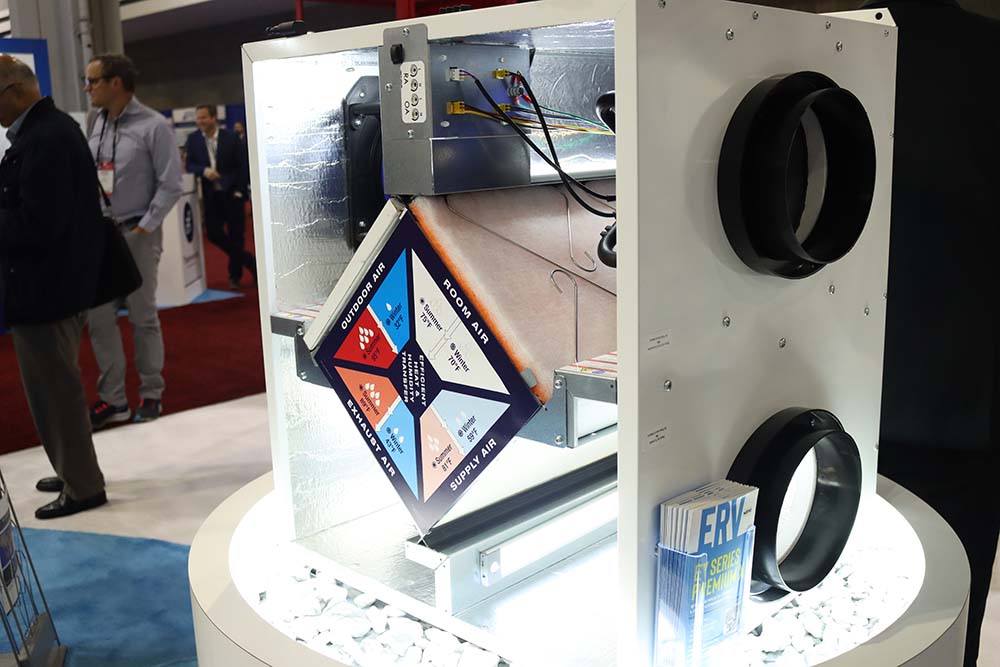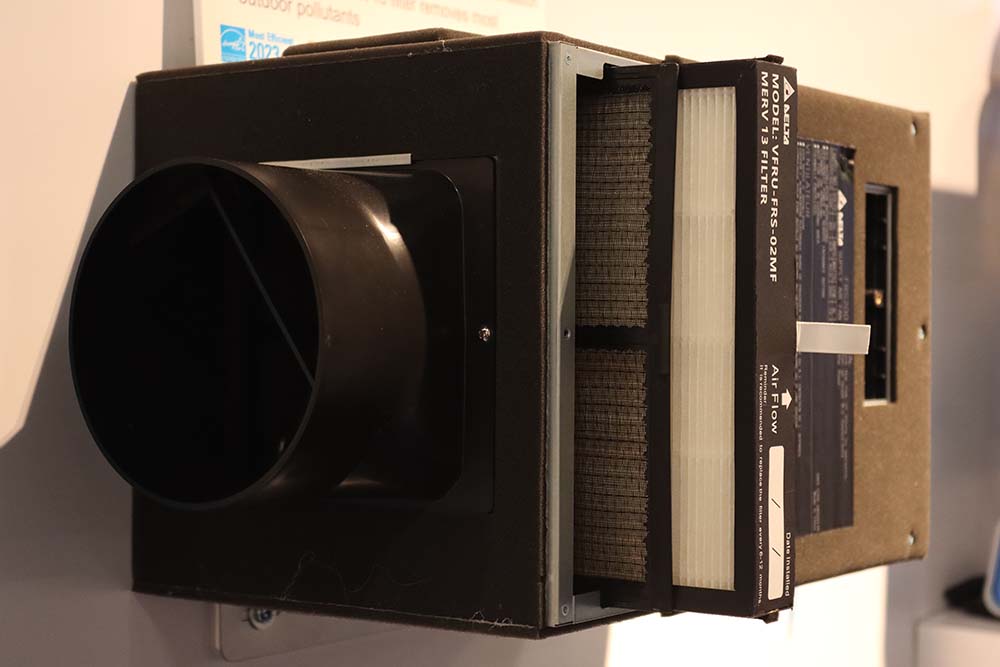“There could be something within the indoor environment that won’t just give you some irritation, but can actually kill you.”
That is the concern that Nick Agopian, vice president of sales and marketing at RenewAire, brought to light at this year’s AHR Expo, which took place in early February. The global pandemic caused many people to reevaluate how they had been living their lives, and when it came to life at home, indoor air quality (IAQ) became a top priority.
RenewAire
vice president of sales and marketing
RenewAire
Most homes are not designed to be occupied 24/7. Agopian explained that realistically, there are periods of time when a home will be left empty — when its inhabitants go to work, school, etc. — and during that time, the house will flush itself out. When people are at home, they generate contaminants through activities such as cooking or cleaning, and with the pandemic and mandated lockdowns, Agopian said many homes did not have the opportunity to come back down to a “steady state concentration,” where the air was no longer hazardous to one’s health.
“These residential products, since the pandemic started, have tripled our sales because the homeowner is starting to educate themselves to say, ‘I need more ventilation.’ They understand that there's a problem occurring in the home,” he said.
According to Agopian, one of the key trends in residential IAQ has been building resiliency. He noted that nowadays, there is a lot of focus on improving the sealing integrity of a built environment. Whether it is the roof, windows, doors, or any other aspect of the home’s foundation, homeowners are looking into building their structures tighter and more secure to increase energy conservation, he said. The downside, however, is that the indoor environment becomes prone to stale, contaminated air.
Agopian said another trend is decarbonization, which can be addressed with Energy Recovery Ventilation (ERV). RenewAire’s EV Series Premium, designed for single family, multifamily, and light commercial applications, utilizes ERV technology to remove contaminants and improve indoor air quality. The system incorporates the use of high-efficiency EC motor fans, features variable-speed boost-mode capabilities, and includes MERV 13 filter accessories.

ERV: The EV Series Premium uses ERV technology to remove contaminants and improve indoor air quality. (Staff photo)
While short-term exposure to contaminated air might not cause immediate harm, Agopian stressed that prolonged exposure does, in fact, have an impact on a person’s total lifespan — described as Disability Adjusted Life Years (DALYs). He briefly mentioned a study that ASHRAE cites frequently, which looks at 75 different reasons why people die young or live with disabilities when they grow older. Two of the top 10 reasons, he said, were related to indoor air quality.
“Codes and standards are just the minimum. When somebody says, ‘Oh, I built to code,’ what you just told me is you built the absolute minimum. Today, there are higher performing standards,” he said. “It's no longer just indoor air quality: It’s health and wellness and safety.”
Delta Electronics
According to Jeff Klonowski, product development manager at Delta Electronics – Americas, “balanced ventilation” is the buzzword for trends in residential IAQ. Most people are familiar with exhaust ventilation, which he said was quite common in the past and has been used in homes for a long time. Nowadays, however, he said that it is not just exhaust — fresh air is also being supplied into homes.
“[We do it] at the same time to eliminate the positive or negative pressures of supply ventilation or exhaust ventilation. So it's better for the building as a whole by eliminating the pressures created by traditional ventilation,” he explained.
Klonowski said instead of selling one fan that does either exhaust or supply ventilation, manufacturers like Delta are starting to sell appliances that do both. Or alternatively, he said, end users might buy two appliances— one dedicated to supply ventilation, one to exhaust — that balance each other out.
Delta’s BreezFresh FRS200 is a fresh air supply fan that can be paired with DeltaBreez exhaust fans to create a balanced ventilation system, Klonowski said. The product is rated for 30-200 cfm and exceeds Energy Star Most Efficient requirements by over 20%. Designed to meet three ventilation functions — supply, balanced, and purification — the FRS200 removes outdoor pollutants from incoming air, with the help of an optional MERV13 filter.

FILTRATION: Delta’s BreezFresh FRS200 can remove outdoor pollutants from incoming air, with the help of a MERV13 filter. (Staff photo)
Another trend, he added, has been ventilation systems that react to changes in the home. For example, he explained that if there was a sudden influx of people within a home, maybe for a party, where there is a lot more CO2 output, that extra foot traffic might degrade the quality of air within the space.
“Especially since the pandemic, people have a heightened awareness of their indoor air quality and I think that certainly is showing in the purchasing that they do for their home and designs for their new homes,” said Klonowski.
Steril-Aire
Considering current trends in residential indoor air quality and the overall awareness of IAQ since the pandemic, Mason Filz, marketing manager at Steril-Aire, said although the company identifies as a mainly commercial business, Steril-Aire has branched out and started to produce products for residential applications.
He explained that while opportunities in this new space are definitely present, a big challenge — or learning curve — is the realization that residential HVAC bring in purchasers who have a different end goal than commercial buyers. While those in the commercial market are primarily concerned with energy savings or overall cost, homeowners are often more invested in providing their living spaces with the cleanest, most comfortable air.
Steril-Aire’s SteriLight Series, available in three Emitter lengths — 16-inch, 20-inch, and 24-inch — is designed for new and retrofit residential and light commercial applications. The product features germicidal UV-C lights, which can destroy mold, bacteria, and viruses before they contaminate the air within a home.
“We have residential units called RSE I and RSE II, and we have an updated version coming out next quarter called the Steril-Home, which is a high output system,” Filz said.
The RSE I is a single residential emitter, designed for slab and slant coils, while the RSE II is a double-residential emitter and can accommodate “A” style, “N” style, “W” style, and counter-flow “A” coils. Both models feature a 120-277 V, 50/60 Hz universal power supply, and, according to Filz, are easy to install within anyone’s home.
According to Josh Oelker, national sales manager, the Steril-Home product installs easier than previous UVC residential solutions, due to its adjustable widths. The device disinfects like a commercial UVC product and provides increased energy efficiency and energy savings, he added.
While the current popularity of IAQ has its benefits, Oelker emphasized that better awareness is not a substitute for viable solutions, such as filtration or UVGI.
“Awareness needs to be preceded by efficacy,” he said.



Report Abusive Comment